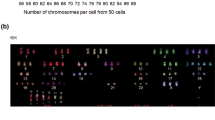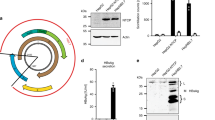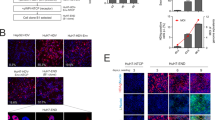Abstract
With a single exception, all isolates of hepatitis C virus (HCV) require adaptive mutations to replicate efficiently in cell culture. Here, we show that a major class of adaptive mutations regulates the activity of a cellular lipid kinase, phosphatidylinositol 4-kinase IIIα (PI4KA). HCV needs to stimulate PI4KA to create a permissive phosphatidylinositol 4-phosphate-enriched membrane microenvironment in the liver and in primary human hepatocytes (PHHs). In contrast, in Huh7 hepatoma cells, the virus must acquire loss-of-function mutations that prevent PI4KA overactivation. This adaptive mechanism is necessitated by increased PI4KA levels in Huh7 cells compared with PHHs, and is conserved across HCV genotypes. PI4KA-specific inhibitors promote replication of unadapted viral isolates and allow efficient replication of patient-derived virus in cell culture. In summary, this study has uncovered a long-sought mechanism of HCV cell-culture adaptation and demonstrates how a virus can adapt to changes in a cellular environment associated with tumorigenesis.
This is a preview of subscription content, access via your institution
Access options
Subscribe to this journal
Receive 12 digital issues and online access to articles
$119.00 per year
only $9.92 per issue
Buy this article
- Purchase on Springer Link
- Instant access to full article PDF
Prices may be subject to local taxes which are calculated during checkout






Similar content being viewed by others
Change history
14 July 2017
In the PDF version of this article previously published, the year of publication provided in the footer of each page and in the 'How to cite' section was erroneously given as 2017, it should have been 2016. This error has now been corrected. The HTML version of the article was not affected.
References
Smith, D. B. et al. Expanded classification of hepatitis C virus into 7 genotypes and 67 subtypes: updated criteria and genotype assignment web resource. Hepatology 59, 318–327 (2014).
Neumann, A. U. et al. Hepatitis C viral dynamics in vivo and the antiviral efficacy of interferon-α therapy. Science 282, 103–107 (1998).
Heim, M. H. & Thimme, R. Innate and adaptive immune responses in HCV infections. J. Hepatol. 61, S14–S25 (2014).
Lohmann, V. et al. Replication of subgenomic hepatitis C virus RNAs in a hepatoma cell line. Science 285, 110–113 (1999).
Lohmann, V., Hoffmann, S., Herian, U., Penin, F. & Bartenschlager, R. Viral and cellular determinants of hepatitis C virus RNA replication in cell culture. J. Virol. 77, 3007–3019 (2003).
Blight, K. J., Kolykhalov, A. A. & Rice, C. M. Efficient initiation of HCV RNA replication in cell culture. Science 290, 1972–1974 (2000).
Balla, A. & Balla, T. Phosphatidylinositol 4-kinases: old enzymes with emerging functions. Trends Cell Biol. 16, 351–361 (2006).
Altan-Bonnet, N. & Balla, T. Phosphatidylinositol 4-kinases: hostages harnessed to build panviral replication platforms. Trends Biochem. Sci. 37, 293–302 (2012).
Reiss, S. et al. The lipid kinase phosphatidylinositol-4 kinase III alpha regulates the phosphorylation status of hepatitis C virus NS5A. PLoS Pathogens 9, e1003359 (2013).
Reiss, S. et al. Recruitment and activation of a lipid kinase by hepatitis C virus NS5A is essential for integrity of the membranous replication compartment. Cell Host Microbe 9, 32–45 (2011).
Berger, K. L., Kelly, S. M., Jordan, T. X., Tartell, M. A. & Randall, G. Hepatitis C virus stimulates the phosphatidylinositol 4-kinase III alpha-dependent phosphatidylinositol 4-phosphate production that is essential for its replication. J. Virol. 85, 8870–8883 (2011).
Wang, H. et al. Oxysterol-binding protein is a phosphatidylinositol 4-kinase effector required for HCV replication membrane integrity and cholesterol trafficking. Gastroenterology 146, 1373–1385 (2014).
Khan, I. et al. Modulation of hepatitis C virus genome replication by glycosphingolipids and four-phosphate adaptor protein 2. J. Virol. 88, 12276–12295 (2014).
Lohmann, V. & Bartenschlager, R. On the history of hepatitis C virus cell culture systems. J. Med. Chem. 57, 1627–1642 (2014).
Steinmann, E. & Pietschmann, T. Cell culture systems for hepatitis C virus. Curr. Top. Microbiol. Immunol. 369, 17–48 (2013).
Vaillancourt, F. H. et al. Evaluation of phosphatidylinositol-4-kinase IIIα as a hepatitis C virus drug target. J. Virol. 86, 11595–11607 (2012).
Romero-Brey, I. et al. Three-dimensional architecture and biogenesis of membrane structures associated with hepatitis C virus replication. PLoS Pathogens 8, e1003056 (2012).
Harak, C. & Lohmann, V. Ultrastructure of the replication sites of positive-strand RNA viruses. Virology 479–480, 418–433 (2015).
Lohmann, V., Körner, F., Dobierzewska, A. & Bartenschlager, R. Mutations in hepatitis C virus RNAs conferring cell culture adaptation. J. Virol. 75, 1437–1449 (2001).
Yi, M. & Lemon, S. M. Adaptive mutations producing efficient replication of genotype 1a hepatitis C virus RNA in normal Huh7 cells. J. Virol. 78, 7904–7915 (2004).
Saeed, M. et al. Efficient replication of genotype 3a and 4a hepatitis C virus replicons in human hepatoma cells. Antimicrob. Agents Chemother. 56, 5365–5373 (2012).
Wose Kinge, C. N. et al. Hepatitis C virus genotype 5a subgenomic replicons for evaluation of direct-acting antiviral agents. Antimicrob. Agents Chemother. 58, 5386–5394 (2014).
Yu, M. et al. Robust and persistent replication of the genotype 6a hepatitis C virus replicon in cell culture. Antimicrob. Agents Chemother. 58, 2638–2646 (2014).
Appel, N., Pietschmann, T. & Bartenschlager, R. Mutational analysis of hepatitis C virus nonstructural protein 5A: potential role of differential phosphorylation in RNA replication and identification of a genetically flexible domain. J. Virol. 79, 3187–3194 (2005).
Lohmann, V. Hepatitis C virus RNA replication. Curr. Top. Microbiol. Immunol. 369, 167–198 (2013).
Neddermann, P. et al. Reduction of hepatitis C virus NS5A hyperphosphorylation by selective inhibition of cellular kinases activates viral RNA replication in cell culture. J. Virol. 78, 13306–13314 (2004).
Pietschmann, T. et al. Production of infectious genotype 1b virus particles in cell culture and impairment by replication enhancing mutations. PLoS Pathogens 5, e1000475 (2009).
Bojjireddy, N. et al. Pharmacological and genetic targeting of the PI4KA enzyme reveals its important role in maintaining plasma membrane phosphatidylinositol 4-phosphate and phosphatidylinositol 4,5-bisphosphate levels. J. Biol. Chem. 289, 6120–6132 (2014).
Jones, C. T. et al. Real-time imaging of hepatitis C virus infection using a fluorescent cell-based reporter system. Nat. Biotechnol. 28, 167–171 (2010).
Ilboudo, A. et al. Overexpression of phosphatidylinositol 4-kinase type IIIα is associated with undifferentiated status and poor prognosis of human hepatocellular carcinoma. BMC Cancer 14, 7 (2014).
Binder, M., Kochs, G., Bartenschlager, R. & Lohmann, V. Hepatitis C virus escape from the interferon regulatory factor 3 pathway by a passive and active evasion strategy. Hepatology 46, 1365–1374 (2007).
Masaki, T. et al. Involvement of hepatitis C virus NS5A hyperphosphorylation mediated by casein kinase I-α in infectious virus production. J. Virol. 88, 7541–7555 (2014).
Ross-Thriepland, D., Mankouri, J. & Harris, M. Serine phosphorylation of the hepatitis C virus NS5A protein controls the establishment of replication complexes. J. Virol. 89, 3123–3135 (2015).
Li, Y. P. et al. Highly efficient full-length hepatitis C virus genotype 1 (strain TN) infectious culture system. Proc. Natl Acad. Sci. USA 109, 19757–19762 (2012).
Li, Y. P., Ramirez, S., Mikkelsen, L. & Bukh, J. Efficient infectious cell culture systems of the hepatitis C virus (HCV) prototype strains HCV-1 and H77. J. Virol. 89, 811–823 (2015).
Ramirez, S., Mikkelsen, L. S., Gottwein, J. M. & Bukh, J. Robust HCV genotype 3a infectious cell culture system permits identification of escape variants with resistance to sofosbuvir. Gastroenterology 151, 973–985 (2016).
Yamane, D. et al. Regulation of the hepatitis C virus RNA replicase by endogenous lipid peroxidation. Nat. Med. 20, 927–935 (2014).
Saeed, M. et al. SEC14L2 enables pan-genotype HCV replication in cell culture. Nature 524, 471–475 (2015).
Jopling, C. L., Yi, M., Lancaster, A. M., Lemon, S. M. & Sarnow, P. Modulation of hepatitis C virus RNA abundance by a liver-specific microRNA. Science 309, 1577–1581 (2005).
Nassirpour, R., Mehta, P. P. & Yin, M. J. miR-122 regulates tumorigenesis in hepatocellular carcinoma by targeting AKT3. PLoS ONE 8, e79655 (2013).
Backes, P. et al. Role of annexin A2 in the production of infectious hepatitis C virus particles. J. Virol. 84, 5775–5789 (2010).
Mayoral, R. J. & Monticelli, S. Stable overexpression of miRNAs in bone marrow-derived murine mast cells using lentiviral expression vectors. Methods Mol. Biol. 667, 205–214 (2010).
Esser-Nobis, K. et al. Analysis of hepatitis C virus resistance to silibinin in vitro and in vivo points to a novel mechanism involving nonstructural protein 4B. Hepatology 57, 953–963 (2013).
Friebe, P., Boudet, J., Simorre, J. P. & Bartenschlager, R. Kissing-loop interaction in the 3′ end of the hepatitis C virus genome essential for RNA replication. J. Virol. 79, 380–392 (2005).
Blight, K. J., McKeating, J. A. & Rice, C. M. Highly permissive cell lines for subgenomic and genomic hepatitis C virus RNA replication. J. Virol. 76, 13001–13014 (2002).
Chhatwal, P. et al. Bile acids specifically increase hepatitis C virus RNA-replication. PLoS ONE 7, e36029 (2012).
Koutsoudakis, G., Herrmann, E., Kallis, S., Bartenschlager, R. & Pietschmann, T. The level of CD81 cell surface expression is a key determinant for productive entry of hepatitis C virus into host cells. J. Virol. 81, 588–598 (2007).
Kleine, M. et al. Explanted diseased livers—a possible source of metabolic competent primary human hepatocytes. PLoS ONE 9, e101386 (2014).
Gondeau, C. et al. In vitro infection of primary human hepatocytes by HCV-positive sera: insights on a highly relevant model. Gut 63, 1490–1500 (2014).
Kaul, A., Worz, I. & Bartenschlager, R. Adaptation of the hepatitis C virus to cell culture. Methods Mol. Biol. 510, 361–372 (2009).
Ye, L. et al. Centrifugal enhancement of hepatitis C virus infection of human hepatocytes. J. Virol. Methods 148, 161–165 (2008).
Hammond, G. R., Schiavo, G. & Irvine, R. F. Immunocytochemical techniques reveal multiple, distinct cellular pools of PtdIns4P and PtdIns(4,5) P2 . Biochem. J. 422, 23–35 (2009).
Acknowledgements
The authors would especially like to thank U. Herian, R. Klein, S. Kallis and M. Bartenschlager for excellent technical assistance. We are grateful to T. Wakita for the JFH-1 isolate, to S. Breitfelder for compounds PI4KA-A and PI4KA-B, J. Botyanszki for compounds PI4KA-F1 and PI4KA-G1 and M. Harris for the polyclonal sheep serum recognizing NS5A. We are grateful to the Electron Microscopy Core Facility at the Bioquant (Heidelberg University) for providing access to their equipment and for excellent support. This project was funded by grants from the Deutsche Forschungsgemeinschaft (LO 1556/1-2, LO 1556/4-1 and TRR77, TPA1 to V.L., and TRR83, TP13 and TRR77, TPA1 to R.B.), as well as an HBIGS Postdoc stipend to C.H. This work was supported in part by the National Institutes of Health National Cancer Institute grant R01CA057973 and National Institute of Allergy and Infectious Diseases grants R01AI072613 and R01AI099284 (to C.M.R.) and by a Helmsley Postdoctoral Fellowship for Basic and Translational Research on Disorders of the Digestive System at The Rockefeller University (to M.S.). The Greenberg Medical Research Institute, Starr Foundation, Ronald A. Shellow, M.D. Memorial Fund and anonymous donors provided additional funding (to C.M.R.).
Author information
Authors and Affiliations
Contributions
C.H. conceived and carried out experiments, interpreted the results and wrote the manuscript. I.R.-B. performed the EM experiments. M.M., C.S., P.S. and K.E.-N. did some of the cell-culture experiments. C.G. did some of the PHH experiments and F.W.R.V. provided PHHs. P.S., D.G., S.P.-d.-P., C.N.-H., R.T. and P.M. provided patient sera and contributed with helpful discussions. P.N. and R.D.F. provided H479 and contributed to the conception of the project. M.S. and C.M.R. provided the gt3–5 replicons and Con1 WT replicon cell lines and contributed to the interpretation of the results. R.B. contributed to the concept of the study and to critical discussions. V.L. designed the concept of the project, interpreted the results and wrote the manuscript. All authors contributed to the writing of the manuscript.
Corresponding author
Ethics declarations
Competing interests
The authors declare no competing financial interests.
Supplementary information
Supplementary information
Supplementary Figures 1–11; Supplementary Table 1; Supplementary References (PDF 4503 kb)
Rights and permissions
About this article
Cite this article
Harak, C., Meyrath, M., Romero-Brey, I. et al. Tuning a cellular lipid kinase activity adapts hepatitis C virus to replication in cell culture. Nat Microbiol 2, 16247 (2017). https://doi.org/10.1038/nmicrobiol.2016.247
Received:
Accepted:
Published:
DOI: https://doi.org/10.1038/nmicrobiol.2016.247
This article is cited by
-
Hepatitis C virus cell culture models: an encomium on basic research paving the road to therapy development
Medical Microbiology and Immunology (2019)
-
Fine tuning HCV replication
Nature Reviews Microbiology (2017)



